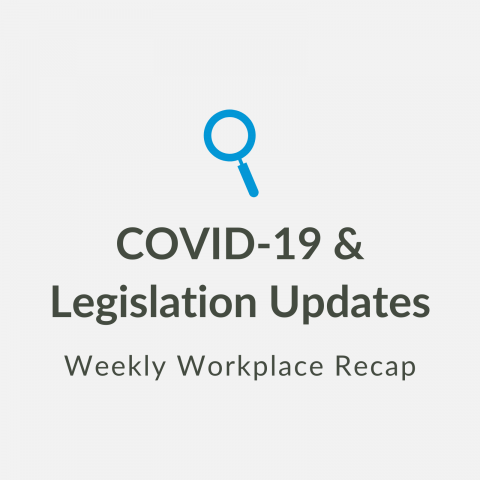COVID-19 & Legislation Updates | Weekly Workplace Recap from January 21 to January 27, 2022

Below are the key COVID-19 & legislation topics that touch on the workplace from January 21 to January 27, 2022.
Federal
CERB doled out $81.64 billion to 8.9 million recipients but warns of potential need for repayments
The Canada Revenue Agency (CRA) is sending out a new round of letters to pandemic aid recipients to verify they were eligible for the help, and warning of potential need for repayments.
It's the second time the agency is mailing Canada Emergency Response Benefit recipients as part of a process to verify the eligibility of the millions of Canadians who received the $500-a-week benefit.
The CRA sent out more than 441,000 letters to CERB recipients near the end of 2020 asking them to verify they met eligibility rules for the payments.
Thousands more are going out beginning today, this time targeting recipients who may have earned more than the $1,000 a month the Liberals allowed beginning in mid-April 2020.
$125M in COVID-19 public health funding to flow directly to First Nations Communities
Indigenous Services Canada is flowing a total of $125 million of COVID-19 public health funding directly to First Nations across the country to support their public health efforts.
This funding can be used by First Nations to support community surge capacity in response to COVID-19. This may include, but is not limited to, continued administration of COVID-19 vaccinations and boosters, implementation of rapid testing, surge infrastructure, surge staff and resources, food security to support self-isolation and supports to update, review and activate pandemic response plans.
Ontario
Ontario outlines three-step plan to loosen restrictions
Effective Jan. 31, 2022 at 12:01 a.m. Ontario will begin the process of gradually easing restrictions, while maintaining protective measures, including but not limited to:
-
Increasing social gathering limits to 10 people indoors and 25 people outdoors.
- Increasing or maintaining capacity limits at 50% in indoor public settings, including but not limited to:
- Restaurants, bars and other food or drink establishments without dance facilities;
- Retailers (including grocery stores and pharmacies)
- Shopping malls;
- Non-spectator areas of sports and recreational fitness facilities, including gyms;
- Cinemas;
- Meeting and event spaces;
- Recreational amenities and amusement parks, including water parks;
- Museums, galleries, aquariums, zoos and similar attractions; and
- Casinos, bingo halls and other gaming establishments
- Religious services, rites, or ceremonies.
- Allowing spectator areas of facilities such as sporting events, concert venues and theatres to operate at 50% seated capacity or 500 people, whichever is less.
Further measures are set to come into effect on Feb. 21 and Mar. 14. See the full list of restrictions in the link below.
Alberta
Rapid asymptomatic COVID-19 screening: Program Overview for employers
Alberta Health has a supply of rapid COVID-19 test kits that are available, at no charge, to select public, private, and not-for-profit employers and service providers to support COVID-19 screening programs in their facilities.
This document (linked below) outlines Alberta’s rapid test program and how organizations can apply for rapid tests. The program overview includes the following sections:
- What is a Screening Test?
- Rapid Asymptomatic COVID-19 Screening in Alberta
- Establishing Your Rapid Asymptomatic COVID-19 Screening Program
- Requesting Rapid Tests
British Columbia
B.C. doubles relief grant for businesses, now providing up to $20,000 in relief
If you own a business in B.C. and found out this week you cannot reopen yet due to COVID-19, you could be eligible to receive up to $20,000 from the provincial government.
In a release Wednesday, the province announced it is extending the COVID-19 Closure Relief Grant and doubling financial supports for eligible businesses that were ordered on Tuesday to remain closed until Feb. 16.
To apply for a grant, visit the official closure relief grant webpage.
Workplace safety orders updated, stating the difference between a communicable disease prevention plan and a COVID-19 safety plan
On January 7, 2022, the provincial health officer (PHO) announced an order requiring employers to re-activate their COVID-19 Safety Plans.
The PHO order on workplace safety issued on January 20, 2022, replaces the previous requirement for employers to have communicable disease prevention plans in their workplaces.
While communicable disease prevention plans and COVID-19 Safety Plans share some of the same fundamental principles, COVID-19 Safety Plans are formal, written plans with more rigorous controls and are more appropriate for periods of elevated risk, such as the one currently faced by B.C. workplaces by the Omicron variant.
WorkSafeBC has resources to re-activate your COVID-19 Safety Plan.
Free supports for rural businesses looking to expand available through Export Navigator program
Business owners in rural and Indigenous communities can benefit from free expert advice and resources as they recover from the pandemic through the province’s Export Navigator program.
Since 2016, Export Navigator has helped more than 700 B.C. businesses export their products across Canada and internationally. Export Navigator advisers help small business owners identify new market opportunities, provide referrals to provincial and federal services, funding and business connections and offer logistical, customs and financing support.


